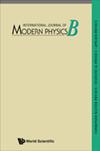变形对Zn原子吸附硼罗芬的影响
IF 2.8
4区 物理与天体物理
Q2 PHYSICS, APPLIED
引用次数: 0
摘要
采用基于密度泛函理论(DFT)的第一性原理计算方法,研究了拉伸和压缩变形对锌原子吸附硼罗芬体系的结构稳定性、电子结构和光学性质的影响,包括反射率、吸收系数、带隙和吸附能。吸附Zn原子后,硼罗芬平面发生畸变。吸附能计算表明,在拉伸应变和压缩应变作用下,材料的稳定性均下降。当拉伸和压缩载荷分别增加到5%时,体系失去稳定性和吸附锌原子的能力。能带结构和态密度分析表明,锌原子吸附改变了硼罗芬的能带结构,在费米能级附近出现能带重叠,在导带中杂质能级较多。Zn原子与硼苯之间在-12 eV ~ 6 eV范围内形成杂化,其中s轨道和p轨道都对导价带有贡献,但p轨道对总态密度的贡献大于s轨道。光学性质的研究表明,拉伸和压缩应变都增加了吸附体系的介电常数,压缩应变引起光谱实部和虚部的主峰红移。拉伸应变对硼罗芬的吸收系数和反射率影响不大。随着压缩应变的增大,被吸附体系的吸收系数峰向蓝色偏移,反射率峰红移。本文章由计算机程序翻译,如有差异,请以英文原文为准。
Effects of deformation on Zn atom-adsorbed borophene
The effects of tensile and compressive deformation on the structural stability, electronic structure and optical properties of the Zn atom-adsorbed borophene system, which are exhibited by reflectivity, absorption coefficient, bandgap and adsorption energy, were studied using the first-principles calculations based on density functional theory (DFT). The borophene planes were found to be distorted following Zn atom adsorption. The adsorption energy calculations show that the stability decreases both under tensile and compressive strains. When tensile and compressive loading increase to 5%, respectively, the system loses the stability and the ability of adsorbing Zn atoms on borophene. The band structure and density of states analysis show that the band structure of borophene is changed by the Zn atom adsorption, with a band overlap near the Fermi level and more impurity energy levels in the conduction band. The hybridization is formed between Zn atom and borophene in the range of –12[Formula: see text]eV to 6[Formula: see text]eV, with the s and p orbitals both contributing to the conduction and valence bands, but p orbitals make a larger contribution to the total density of states than s orbitals. Studies of optical properties have shown that tensile and compressive strains both increase the dielectric constant of the adsorbed system, with compressive strains causing a redshift in the major peaks of the real and imaginary parts of the spectrum. The tensile strain has little effect on the absorption coefficient and reflectance of the borophene. As the compressive strain increases, the peak absorption coefficient of the adsorbed system is shifted to the blue and the peak reflectance is redshifted.
求助全文
通过发布文献求助,成功后即可免费获取论文全文。
去求助
来源期刊

International Journal of Modern Physics B
物理-物理:凝聚态物理
CiteScore
3.70
自引率
11.80%
发文量
417
审稿时长
3.1 months
期刊介绍:
Launched in 1987, the International Journal of Modern Physics B covers the most important aspects and the latest developments in Condensed Matter Physics, Statistical Physics, as well as Atomic, Molecular and Optical Physics. A strong emphasis is placed on topics of current interest, such as cold atoms and molecules, new topological materials and phases, and novel low dimensional materials. One unique feature of this journal is its review section which contains articles with permanent research value besides the state-of-the-art research work in the relevant subject areas.
 求助内容:
求助内容: 应助结果提醒方式:
应助结果提醒方式:


